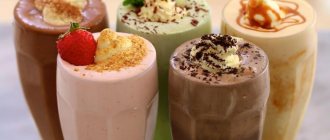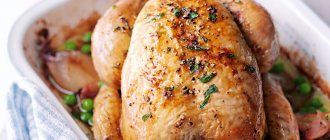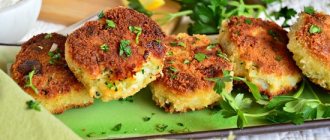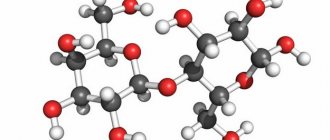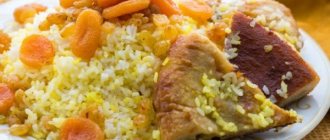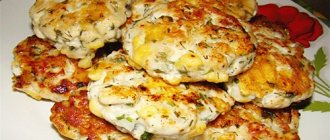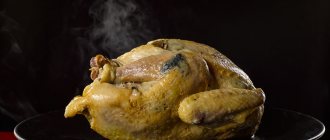Calorie content Nuts with condensed milk. Chemical composition and nutritional value.
Nutritional value and chemical composition of “Nuts with condensed milk.”
The table shows the nutritional content (calories, proteins, fats, carbohydrates, vitamins and minerals) per 100 grams of edible portion.
| Nutrient | Quantity | Norm** | % of the norm in 100 g | % of the norm in 100 kcal | 100% normal |
| Calorie content | 270 kcal | 1684 kcal | 16% | 5.9% | 624 g |
| Squirrels | 3.2 g | 76 g | 4.2% | 1.6% | 2375 g |
| Fats | 11.9 g | 56 g | 21.3% | 7.9% | 471 g |
| Carbohydrates | 38.5 g | 219 g | 17.6% | 6.5% | 569 g |
| Organic acids | 0.7 g | ~ | |||
| Alimentary fiber | 1.5 g | 20 g | 7.5% | 2.8% | 1333 g |
| Water | 12.4 g | 2273 g | 0.5% | 0.2% | 18331 g |
| Ash | 0.5 g | ~ | |||
| Vitamins | |||||
| Vitamin A, RE | 182 mcg | 900 mcg | 20.2% | 7.5% | 495 g |
| Retinol | 0.165 mg | ~ | |||
| beta carotene | 0.115 mg | 5 mg | 2.3% | 0.9% | 4348 g |
| Vitamin B1, thiamine | 0.09 mg | 1.5 mg | 6% | 2.2% | 1667 g |
| Vitamin B2, riboflavin | 0.08 mg | 1.8 mg | 4.4% | 1.6% | 2250 g |
| Vitamin E, alpha tocopherol, TE | 0.9 mg | 15 mg | 6% | 2.2% | 1667 g |
| Vitamin RR, NE | 4.6 mg | 20 mg | 23% | 8.5% | 435 g |
| Niacin | 0.6 mg | ~ | |||
| Macronutrients | |||||
| Potassium, K | 156 mg | 2500 mg | 6.2% | 2.3% | 1603 g |
| Calcium, Ca | 30 mg | 1000 mg | 3% | 1.1% | 3333 g |
| Magnesium, Mg | 11 mg | 400 mg | 2.8% | 1% | 3636 g |
| Sodium, Na | 79 mg | 1300 mg | 6.1% | 2.3% | 1646 g |
| Phosphorus, P | 62 mg | 800 mg | 7.8% | 2.9% | 1290 g |
| Microelements | |||||
| Iron, Fe | 1.4 mg | 18 mg | 7.8% | 2.9% | 1286 g |
| Digestible carbohydrates | |||||
| Starch and dextrins | 25.3 g | ~ | |||
| Mono- and disaccharides (sugars) | 26.8 g | max 100 g | |||
| Sterols (sterols) | |||||
| Cholesterol | 105 mg | max 300 mg | |||
| Saturated fatty acids | |||||
| Saturated fatty acids | 18 g | max 18.7 g |
Properties of nut cookies with condensed milk
How much do nut cookies with condensed milk cost (average price for 1 kg)?
Moscow and Moscow region.
100 rub.
Such a confectionery product as nuts with condensed milk can easily be included in the list of confectionery products that are familiar to almost every resident of our latitudes since childhood. Our grandmothers and mothers also made nut cookies with condensed milk for holidays or important events. Many people still have cast iron molds for baking the base for nut cookies with condensed milk.
Once upon a time, the whole family waited for the housewife to boil condensed milk, and then prepare delicious and nutritious nut cookies with condensed milk. Nowadays, nut cookies with condensed milk can be freely purchased in many grocery stores. However, almost everyone who remembers the taste of those homemade Soviet sweets unanimously affirms that modern store-bought cookies cannot be compared with mother’s or grandmother’s nuts with condensed milk.
In accordance with the classification used in the food industry, nuts with condensed milk are classified as liver. In turn, cookies are understood as small-sized confectionery products that are baked from various types of dough. As a rule, in addition to sweet dough, cookies contain various food additives, such as nuts, icing, jam or jam, as well as chocolate, caramel and other confectionery decorations.
Nut cookies with condensed milk differ from the classic type of confectionery in its shape, as well as the presence of filling. Due to its highly nutritious composition, the calorie content of nuts with condensed milk is at a fairly high level. Moreover, the calorie content of nuts with condensed milk may vary depending on various additional flavoring additives that are used in the process of preparing cookies.
As a rule, in addition to condensed milk, ground nuts, coconut flakes, and other confectionery decorations can be used to make cookies. The process of making chocolate covered nut cookies takes place in two main stages. Initially, the base for nuts with condensed milk is baked using a mold, and then the confectionery product is filled with pre-cooked condensed milk.
To prepare the dough, the following ingredients are used: chicken egg, wheat flour, margarine for baking, as well as soda and vinegar. Instead of baking soda and vinegar, you can use baking powder or baking powder. If you are sorely short of time to prepare dough for nuts with condensed milk, you can use a ready-made dry mixture for baking.
The filling for cookies is best made from ordinary whole condensed milk, which is boiled for about two hours directly in a tin can in a pan of water. Nut cookies with condensed milk are served as an independent sweet treat, and are also used as components or confectionery decorations in the process of making cakes or desserts.
Calorie content Nuts with condensed milk. Chemical composition and nutritional value.
Nuts with condensed milk are rich in vitamins and minerals such as: vitamin A - 32%, vitamin B1 - 13.7%, vitamin B2 - 20%, choline - 22.9%, vitamin B5 - 12.5%, vitamin B9 - 18 .8%, vitamin B12 - 13%, vitamin D - 14%, vitamin E - 19%, vitamin K - 20.4%, phosphorus - 14.9%, iron - 11.2%, selenium - 43.6%
- Vitamin A is responsible for normal development, reproductive function, skin and eye health, and maintaining immunity.
- Vitamin B1 is part of the most important enzymes of carbohydrate and energy metabolism, providing the body with energy and plastic substances, as well as the metabolism of branched amino acids. A lack of this vitamin leads to serious disorders of the nervous, digestive and cardiovascular systems.
- Vitamin B2 is involved in redox reactions, helps to increase the color sensitivity of the visual analyzer and dark adaptation. Insufficient intake of vitamin B2 is accompanied by impaired condition of the skin, mucous membranes, and impaired light and twilight vision.
- Choline is part of lecithin, plays a role in the synthesis and metabolism of phospholipids in the liver, is a source of free methyl groups, and acts as a lipotropic factor.
- Vitamin B5 is involved in protein, fat, carbohydrate metabolism, cholesterol metabolism, the synthesis of a number of hormones, hemoglobin, promotes the absorption of amino acids and sugars in the intestines, and supports the function of the adrenal cortex. A lack of pantothenic acid can lead to damage to the skin and mucous membranes.
- Vitamin B9 as a coenzyme is involved in the metabolism of nucleic acids and amino acids. Folate deficiency leads to disruption of the synthesis of nucleic acids and proteins, resulting in inhibition of cell growth and division, especially in rapidly proliferating tissues: bone marrow, intestinal epithelium, etc. Insufficient folate intake during pregnancy is one of the causes of prematurity, malnutrition, and congenital deformities and child development disorders. A strong relationship has been shown between folate and homocysteine levels and the risk of cardiovascular disease.
- Vitamin B12 plays an important role in the metabolism and transformation of amino acids. Folate and vitamin B12 are interconnected vitamins that are involved in hematopoiesis. A lack of vitamin B12 leads to the development of partial or secondary folate deficiency, as well as anemia, leukopenia, and thrombocytopenia.
- Vitamin D maintains calcium and phosphorus homeostasis and carries out the processes of bone tissue mineralization. A lack of vitamin D leads to impaired metabolism of calcium and phosphorus in the bones, increased demineralization of bone tissue, which leads to an increased risk of developing osteoporosis.
- Vitamin E has antioxidant properties, is necessary for the functioning of the gonads and heart muscle, and is a universal stabilizer of cell membranes. With vitamin E deficiency, hemolysis of erythrocytes and neurological disorders are observed.
- Vitamin K regulates blood clotting. A lack of vitamin K leads to an increase in blood clotting time and a decreased level of prothrombin in the blood.
- Phosphorus takes part in many physiological processes, including energy metabolism, regulates acid-base balance, is part of phospholipids, nucleotides and nucleic acids, and is necessary for the mineralization of bones and teeth. Deficiency leads to anorexia, anemia, and rickets.
- Iron is part of proteins with various functions, including enzymes. Participates in the transport of electrons and oxygen, ensures the occurrence of redox reactions and activation of peroxidation. Insufficient consumption leads to hypochromic anemia, myoglobin deficiency atony of skeletal muscles, increased fatigue, myocardiopathy, and atrophic gastritis.
- Selenium is an essential element of the antioxidant defense system of the human body, has an immunomodulatory effect, and is involved in the regulation of the action of thyroid hormones. Deficiency leads to Kashin-Beck disease (osteoarthritis with multiple deformities of the joints, spine and limbs), Keshan disease (endemic myocardiopathy), and hereditary thrombasthenia.
Recipe for cookies with condensed milk. Calorie, chemical composition and nutritional value.
Nutritional value and chemical composition of “Cookies with condensed milk.”
The table shows the nutritional content (calories, proteins, fats, carbohydrates, vitamins and minerals) per 100 grams of edible portion.
| Nutrient | Quantity | Norm** | % of the norm in 100 g | % of the norm in 100 kcal | 100% normal |
| Calorie content | 452.3 kcal | 1684 kcal | 26.9% | 5.9% | 372 g |
| Squirrels | 9.6 g | 76 g | 12.6% | 2.8% | 792 g |
| Fats | 24 g | 56 g | 42.9% | 9.5% | 233 g |
| Carbohydrates | 49.3 g | 219 g | 22.5% | 5% | 444 g |
| Organic acids | 0.2 g | ~ | |||
| Alimentary fiber | 2 g | 20 g | 10% | 2.2% | 1000 g |
| Water | 13.8 g | 2273 g | 0.6% | 0.1% | 16471 g |
| Ash | 1.176 g | ~ | |||
| Vitamins | |||||
| Vitamin A, RE | 142.7 mcg | 900 mcg | 15.9% | 3.5% | 631 g |
| Retinol | 0.129 mg | ~ | |||
| beta carotene | 0.081 mg | 5 mg | 1.6% | 0.4% | 6173 g |
| Vitamin B1, thiamine | 0.115 mg | 1.5 mg | 7.7% | 1.7% | 1304 g |
| Vitamin B2, riboflavin | 0.242 mg | 1.8 mg | 13.4% | 3% | 744 g |
| Vitamin B4, choline | 67.08 mg | 500 mg | 13.4% | 3% | 745 g |
| Vitamin B5, pantothenic | 0.644 mg | 5 mg | 12.9% | 2.9% | 776 g |
| Vitamin B6, pyridoxine | 0.156 mg | 2 mg | 7.8% | 1.7% | 1282 g |
| Vitamin B9, folates | 16.197 mcg | 400 mcg | 4% | 0.9% | 2470 g |
| Vitamin B12, cobalamin | 0.285 mcg | 3 mcg | 9.5% | 2.1% | 1053 g |
| Vitamin C, ascorbic acid | 0.45 mg | 90 mg | 0.5% | 0.1% | 20000 g |
| Vitamin D, calciferol | 0.547 mcg | 10 mcg | 5.5% | 1.2% | 1828 |
| Vitamin E, alpha tocopherol, TE | 1.203 mg | 15 mg | 8% | 1.8% | 1247 g |
| Vitamin H, biotin | 4.883 mcg | 50 mcg | 9.8% | 2.2% | 1024 g |
| Vitamin K, phylloquinone | 1.9 mcg | 120 mcg | 1.6% | 0.4% | 6316 g |
| Vitamin RR, NE | 2.8843 mg | 20 mg | 14.4% | 3.2% | 693 g |
| Niacin | 1.003 mg | ~ | |||
| Macronutrients | |||||
| Potassium, K | 244.07 mg | 2500 mg | 9.8% | 2.2% | 1024 g |
| Calcium, Ca | 136.06 mg | 1000 mg | 13.6% | 3% | 735 g |
| Silicon, Si | 4.084 mg | 30 mg | 13.6% | 3% | 735 g |
| Magnesium, Mg | 32.48 mg | 400 mg | 8.1% | 1.8% | 1232 g |
| Sodium, Na | 71.47 mg | 1300 mg | 5.5% | 1.2% | 1819 |
| Sera, S | 87.63 mg | 1000 mg | 8.8% | 1.9% | 1141 g |
| Phosphorus, P | 163.7 mg | 800 mg | 20.5% | 4.5% | 489 g |
| Chlorine, Cl | 117.27 mg | 2300 mg | 5.1% | 1.1% | 1961 |
| Microelements | |||||
| Aluminium, Al | 456.3 mcg | ~ | |||
| Bor, B | 20.7 mcg | ~ | |||
| Vanadium, V | 40.42 mcg | ~ | |||
| Iron, Fe | 1.033 mg | 18 mg | 5.7% | 1.3% | 1742 g |
| Yod, I | 5.62 mcg | 150 mcg | 3.7% | 0.8% | 2669 g |
| Cobalt, Co | 2.752 mcg | 10 mcg | 27.5% | 6.1% | 363 g |
| Lithium, Li | 0.344 mcg | ~ | |||
| Manganese, Mn | 0.3738 mg | 2 mg | 18.7% | 4.1% | 535 g |
| Copper, Cu | 103.16 mcg | 1000 mcg | 10.3% | 2.3% | 969 g |
| Molybdenum, Mo | 5.929 mcg | 70 mcg | 8.5% | 1.9% | 1181 g |
| Nickel, Ni | 1.162 mcg | ~ | |||
| Tin, Sn | 2.03 mcg | ~ | |||
| Rubidium, Rb | 0.3 mcg | ~ | |||
| Selenium, Se | 7.927 mcg | 55 mcg | 14.4% | 3.2% | 694 g |
| Strontium, Sr | 6.32 mcg | ~ | |||
| Titanium, Ti | 5.71 mcg | ~ | |||
| Fluorine, F | 31.66 mcg | 4000 mcg | 0.8% | 0.2% | 12634 g |
| Chromium, Cr | 1.63 mcg | 50 mcg | 3.3% | 0.7% | 3067 g |
| Zinc, Zn | 0.9787 mg | 12 mg | 8.2% | 1.8% | 1226 g |
| Zirconium, Zr | 2.29 mcg | ~ | |||
| Digestible carbohydrates | |||||
| Starch and dextrins | 26.837 g | ~ | |||
| Mono- and disaccharides (sugars) | 22 g | max 100 g | |||
| Lactose | 4.737 g | ~ | |||
| Sucrose | 16.484 g | ~ | |||
| Essential amino acids | 1.148 g | ~ | |||
| Arginine* | 0.224 g | ~ | |||
| Valin | 0.283 g | ~ | |||
| Histidine* | 0.116 g | ~ | |||
| Isoleucine | 0.245 g | ~ | |||
| Leucine | 0.361 g | ~ | |||
| Lysine | 0.328 g | ~ | |||
| Methionine | 0.119 g | ~ | |||
| Methionine + Cysteine | 0.177 g | ~ | |||
| Threonine | 0.204 g | ~ | |||
| Tryptophan | 0.071 g | ~ | |||
| Phenylalanine | 0.216 g | ~ | |||
| Phenylalanine+Tyrosine | 0.398 g | ~ | |||
| Nonessential amino acids | 1.81 g | ~ | |||
| Alanin | 0.19 g | ~ | |||
| Aspartic acid | 0.377 g | ~ | |||
| Glycine | 0.117 g | ~ | |||
| Glutamic acid | 0.887 g | ~ | |||
| Proline | 0.361 g | ~ | |||
| Serin | 0.289 g | ~ | |||
| Tyrosine | 0.199 g | ~ | |||
| Cysteine | 0.066 g | ~ | |||
| Sterols (sterols) | |||||
| Cholesterol | 113.16 mg | max 300 mg | |||
| Saturated fatty acids | |||||
| Saturated fatty acids | 14.4 g | max 18.7 g | |||
| 4:0 Oil | 0.566 g | ~ | |||
| 6:0 Kapronovaya | 0.271 g | ~ | |||
| 8:0 Caprylic | 0.282 g | ~ | |||
| 10:0 Kaprinovaya | 0.431 g | ~ | |||
| 12:0 Lauric | 1.266 g | ~ | |||
| 14:0 Miristinovaya | 2.033 g | ~ | |||
| 15:0 Pentadecane | 0.001 g | ~ | |||
| 16:0 Palmitinaya | 5.058 g | ~ | |||
| 17:0 Margarine | 0.003 g | ~ | |||
| 18:0 Stearic | 1.643 g | ~ | |||
| 20:0 Arakhinovaya | 0.003 g | ~ | |||
| Monounsaturated fatty acids | 6.894 g | min 16.8 g | 41% | 9.1% | |
| 14:1 Myristoleic | 0.324 g | ~ | |||
| 16:1 Palmitoleic | 0.534 g | ~ | |||
| 17:1 Heptadecene | 0.001 g | ~ | |||
| 18:1 Oleic (omega-9) | 5.288 g | ~ | |||
| 20:1 Gadoleic (omega-9) | 0.005 g | ~ | |||
| Polyunsaturated fatty acids | 1.233 g | from 11.2 to 20.6 g | 11% | 2.4% | |
| 18:2 Linolevaya | 0.409 g | ~ | |||
| 18:3 Linolenic | 0.044 g | ~ | |||
| 20:4 Arachidonic | 0.042 g | ~ | |||
| Omega-3 fatty acids | 0.1 g | from 0.9 to 3.7 g | 11.1% | 2.5% | |
| Omega-6 fatty acids | 1.2 g | from 4.7 to 16.8 g | 25.5% | 5.6% |
The energy value of Cookies with condensed milk is 452.3 kcal.
Primary Source: Created in the application by the user. Read more.
** This table shows the average levels of vitamins and minerals for an adult. If you want to know the norms taking into account your gender, age and other factors, then use the “My Healthy Diet” application.

